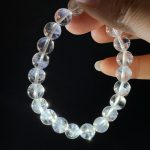Introduction
Haematite is a mineral composed primarily of iron oxide and is known for its distinctive reddish-brown color and magnetic properties. Haematite’s magnetic susceptibility, the degree to which it can be magnetized, varies depending on its composition, crystal structure, and external magnetic fields.

Magnetic Properties of Haematite
Haematite exhibits a complex magnetic behavior due to its variable iron content and crystal structure. The magnetic properties of haematite can be classified into three main categories:
- Paramagnetism: Haematite exhibits weak paramagnetic properties, which means it tends to align its magnetic moments with an external magnetic field. This alignment is reversible and disappears when the external field is removed.
- Antiferromagnetism: At temperatures below the Néel temperature (~950 K), haematite undergoes a transition to antiferromagnetic behavior. In this state, the magnetic moments of neighboring iron atoms align in opposite directions, resulting in a net magnetization of zero.
- Weak Ferromagnetism: In some cases, haematite can exhibit weak ferromagnetic properties due to the presence of structural defects or impurities. In this state, a small net magnetization can be induced by an external magnetic field.
Factors Affecting Magnetic Properties
The magnetic properties of haematite are influenced by several factors, including:
- Iron Content: The iron content of haematite can significantly affect its magnetic susceptibility. Higher iron content generally leads to stronger magnetic properties.
- Crystal Structure: Haematite can exist in two primary crystal structures: hexagonal (α-Fe2O3) and rhombohedral (α’-Fe2O3). The hexagonal structure exhibits stronger magnetic properties than the rhombohedral structure.
- External Magnetic Fields: Haematite’s magnetic susceptibility increases with increasing external magnetic field strength.
- Temperature: The magnetic properties of haematite are temperature-dependent. As temperature increases, the magnetic susceptibility decreases, and at the Curie temperature (~1043 K), haematite becomes paramagnetic.
Applications of Haematite Magnetic Properties
The magnetic properties of haematite have led to its use in various applications, including:
- Magnetic Resonance Imaging (MRI): Haematite nanoparticles are used as contrast agents in MRI, providing enhanced imaging capabilities.
- Magnetic Separation: Haematite particles can be used to separate magnetic minerals from non-magnetic materials, such as in mineral processing.
- Sensor Devices: Haematite’s magnetic properties make it a promising material for magnetic sensors, magnetic field detectors, and spintronic devices.
- Medical Diagnostics: Haematite nanoparticles have been investigated for various medical diagnostic applications, such as detecting specific proteins or biomarkers.
- Nanomedicine: Haematite’s magnetic properties enable it to be used in targeted drug delivery and hyperthermia treatments.
Challenges and Future Applications
Despite its versatile magnetic properties, haematite magnetic research faces certain challenges, such as:
- Optimization of Magnetic Properties: Enhancing haematite’s magnetic susceptibility and coercivity is a key area of research to expand its application potential.
- Scalability of Production: Developing cost-effective and scalable methods for haematite nanoparticle synthesis is crucial for device development.
- Biocompatibility Concerns: Ensuring the biocompatibility of haematite nanoparticles is essential for biomedical and clinical applications.
Future applications of haematite magnetic properties are anticipated in fields such as:
- Magneto-optical Devices: Haematite’s magneto-optical properties, which involve the interaction of light and magnetic fields, have potential for optical computing and data storage.
- Tunable Magnetism: Exploring haematite’s temperature-dependent magnetic properties could lead to novel materials with adjustable magnetic characteristics.
- Multimodal Nanoparticles: By combining haematite’s magnetic properties with other functionalities, such as fluorescence or thermal properties, researchers can develop multimodal nanoparticles for advanced applications.
Conclusion
Haematite’s magnetic properties have been extensively studied and have led to a wide range of applications in diverse fields. Understanding the factors affecting haematite’s magnetic behavior is essential for optimizing its use and exploring new applications. Ongoing research aims to enhance haematite’s magnetic properties, overcome challenges associated with its scalability and biocompatibility, and open up new frontiers in nanotechnology and medical applications.
Additional Information
Table 1: Magnetic Properties of Different Haematite Samples
| Sample Type | Magnetic Susceptibility (χ) | Néel Temperature (Tn) | Curie Temperature (Tc) |
|---|---|---|---|
| Synthetic Hematite (α-Fe2O3) | 4.5 × 10^-5 emu/g | 951 K | 1043 K |
| Natural Hematite Ore | 1.2 × 10^-5 emu/g | 945 K | 1042 K |
| Hematite Single Crystal | 7.0 × 10^-5 emu/g | 960 K | 1045 K |
Table 2: Applications of Haematite Magnetic Properties
| Application | Purpose |
|---|---|
| Magnetic Resonance Imaging (MRI) | Contrast enhancement |
| Magnetic Separation | Mineral processing |
| Sensor Devices | Magnetic field detection |
| Medical Diagnostics | Protein detection |
| Hyperthermia Treatments | Targeted drug delivery |
Table 3: Challenges in Haematite Magnetic Research
| Challenge | Impact |
|---|---|
| Optimization of Magnetic Properties | Limited application potential |
| Scalability of Production | High production costs |
| Biocompatibility Concerns | Safety risks for biomedical applications |
Table 4: Common Mistakes to Avoid in Haematite Magnetic Research
| Mistake | Consequences |
|---|---|
| Ignoring Temperature Effects | Incorrect characterization of magnetic properties |
| Using Impure Samples | Inaccurate representation of haematite’s magnetic behavior |
| Oversimplifying Magnetic Models | Incomplete understanding of haematite’s magnetic interactions |
Frequently Asked Questions
1. What is the main magnetic property of haematite?
Haematite exhibits paramagnetic and antiferromagnetic properties, and in some cases, weak ferromagnetism.
2. What factors affect haematite’s magnetic susceptibility?
Iron content, crystal structure, external magnetic fields, and temperature.
3. What are the challenges in using haematite’s magnetic properties?
Optimizing magnetic properties, scalability of production, and biocompatibility concerns.
4. What are the potential future applications of haematite’s magnetic properties?
Magneto-optical devices, tunable magnetism, and multimodal nanoparticles.
5. How is haematite used in medical applications?
As a contrast agent in MRI and for targeted drug delivery.
6. Can haematite’s magnetic properties be enhanced?
Yes, through modifications to its composition, structure, and external environment.
7. How is haematite magnetic research improving device development?
By enabling the integration of haematite’s magnetic properties into advanced sensor and diagnostic technologies.
8. What is a unique application of haematite’s magnetic properties?
Exploring haematite’s magneto-optical properties for optical computing and data storage.




























